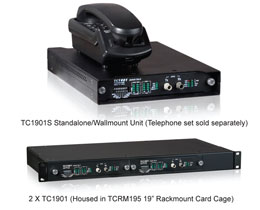News and Product Updates
Fiber Optic Telephone Extender or PBX-Compatible RS-232 Adds New Dimension to Fiber Data Networks
01/28/2000The TC1900 “Quick-Talk” RS-232 or Fiber Telephone Extender can turn a fiber optic network or RS-232 circuit into a voice network simply by plugging a telephone set into an RJ-11 (or DB25) connector. It is compatible with most PBXs or Key Systems.
Quick-Talk is typically used to extend dial-up phone service to remote sites over a fiber optic and/or RS-232 circuit. For example, a user could extend a secure phone link to a remote site with either fiber optic cable or an installed RS-232 connectivity device, such as a Short Haul Modem or the RS-232 port on a Channel Bank.

Quick-Talk provides 2-wire FXO on the telephone side and FXS on the PBX side. When both sides are set to FXS, a "Hot Link" can be established; when one side lifts up the handset, the other side starts ringing. Because it digitizes the analog voice signals (converts them to PCM), voice quality does not degrade over extended distances.
Available in standalone or rackmount versions, the TC1900 is compatible with all popular types and sizes of fiber optic cable. It is also compatible with TC Communications RS-232 products and most non-TC Communications RS-232 products. Diagnostic aids include 16 diagnostic LEDs for indicating power, local & remote signal status, and audio activity.
Quick-Talk is available with RS-232 or optical interfaces. The optical interface is available in multimode (850/1300nm) or single mode (1300/1550nm) versions, with ST or FC connectors. A local dry contact alarm relay is also provided.
Power is 9 to 12VDC or 115/230VAC with an external power cube. Power options include -24VDC or -48VDC. Power redundancy is standard. An extreme temperature version (-20o to 70o) is optional. Electrical connector is DB9 Female.